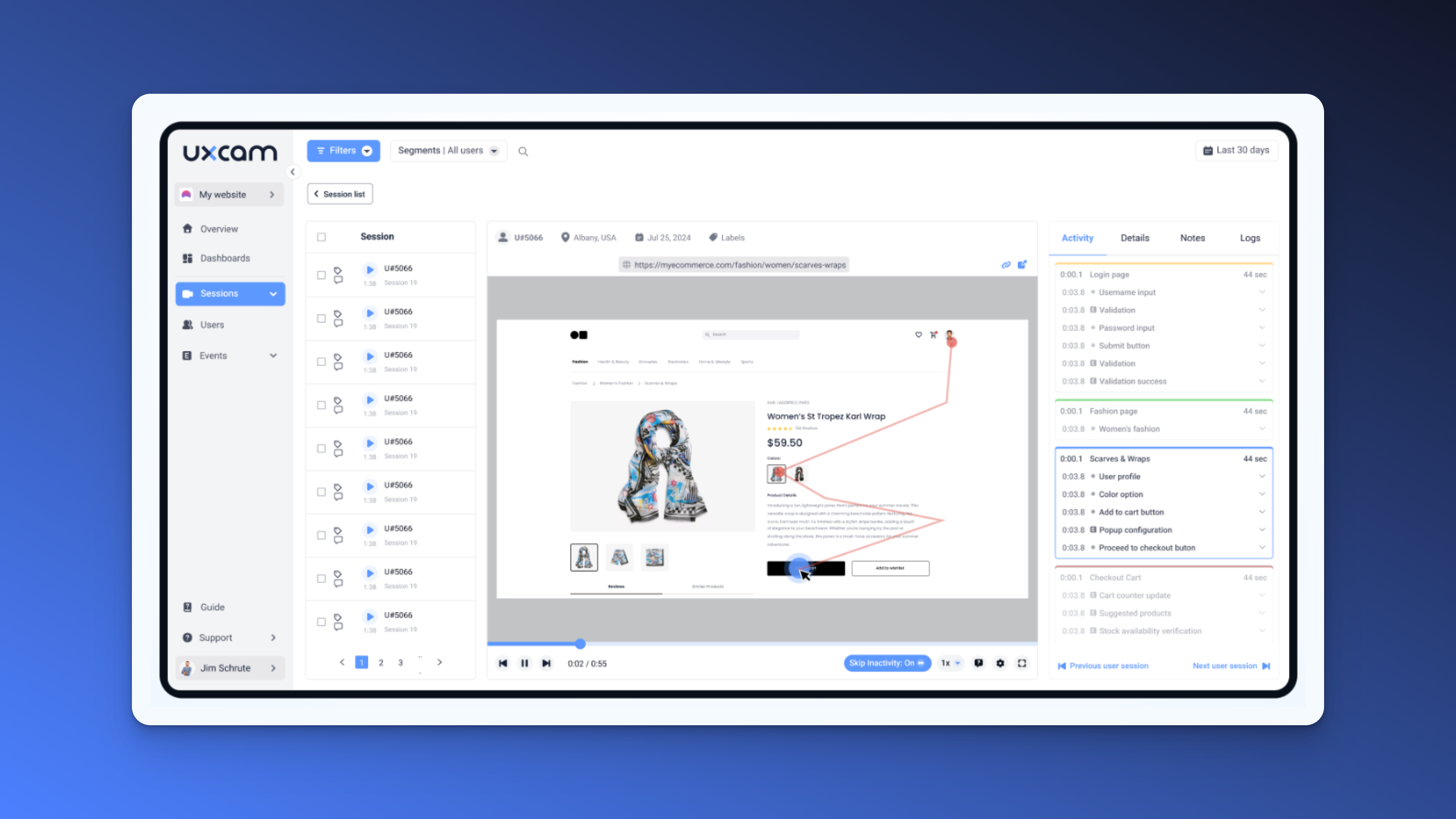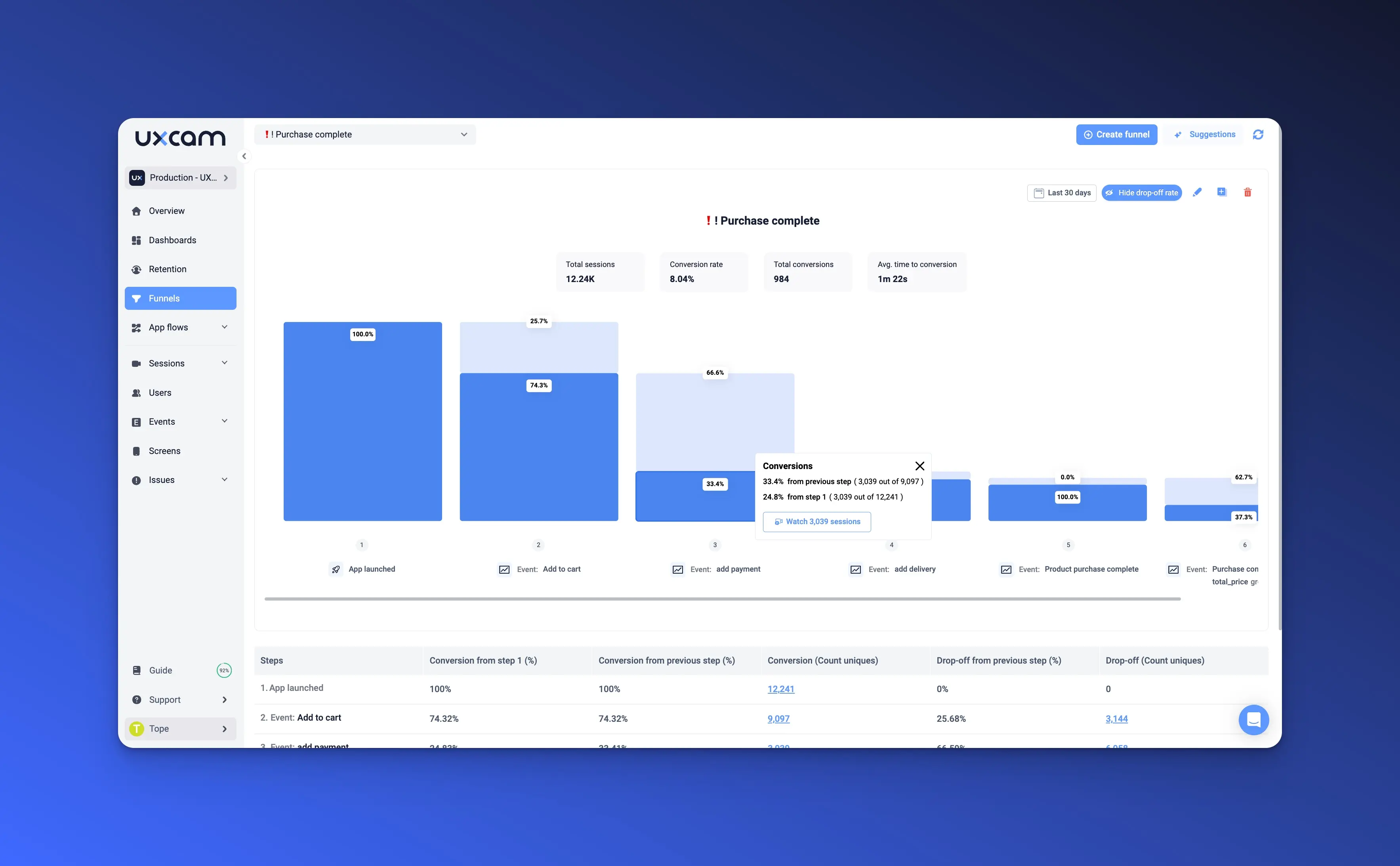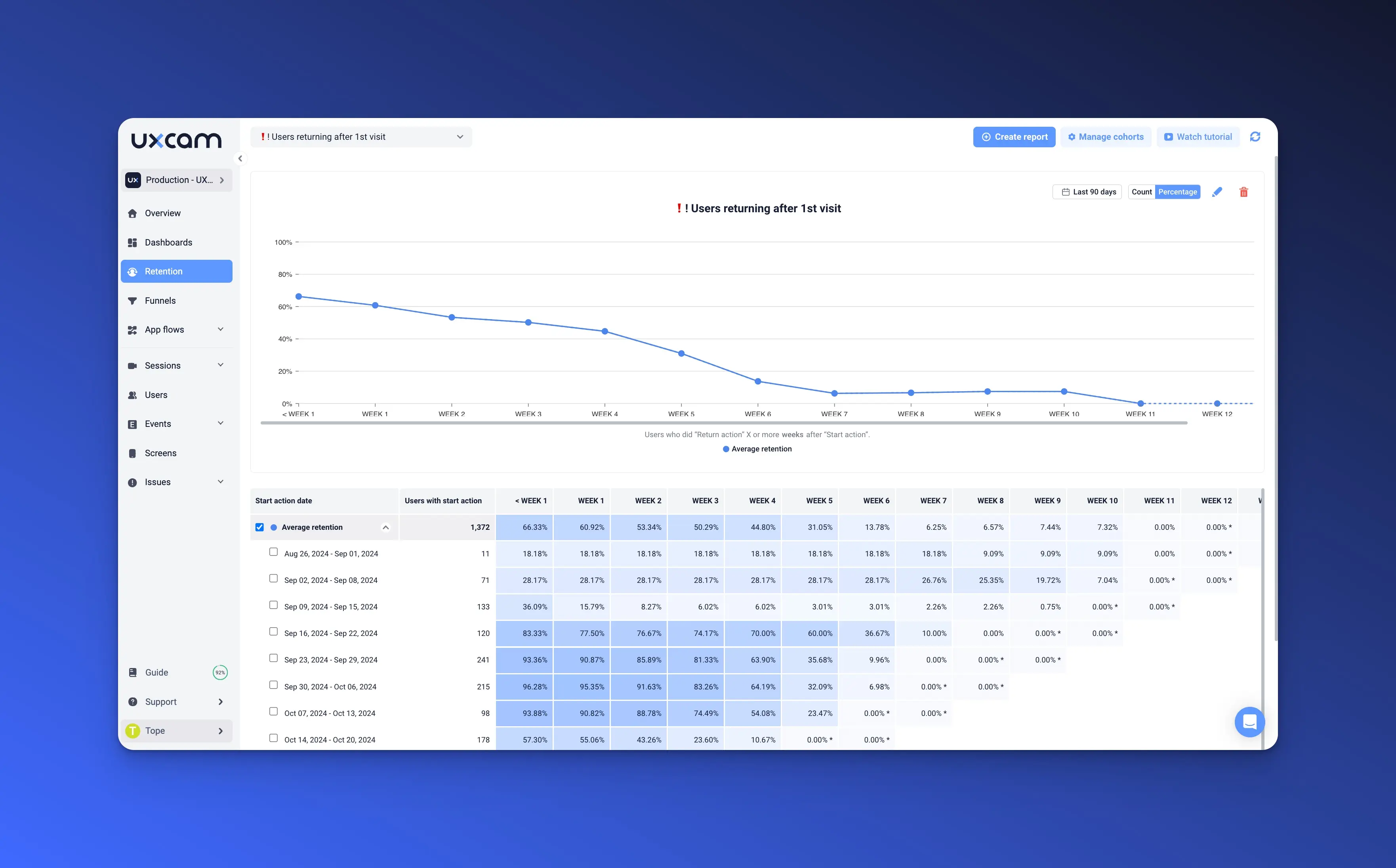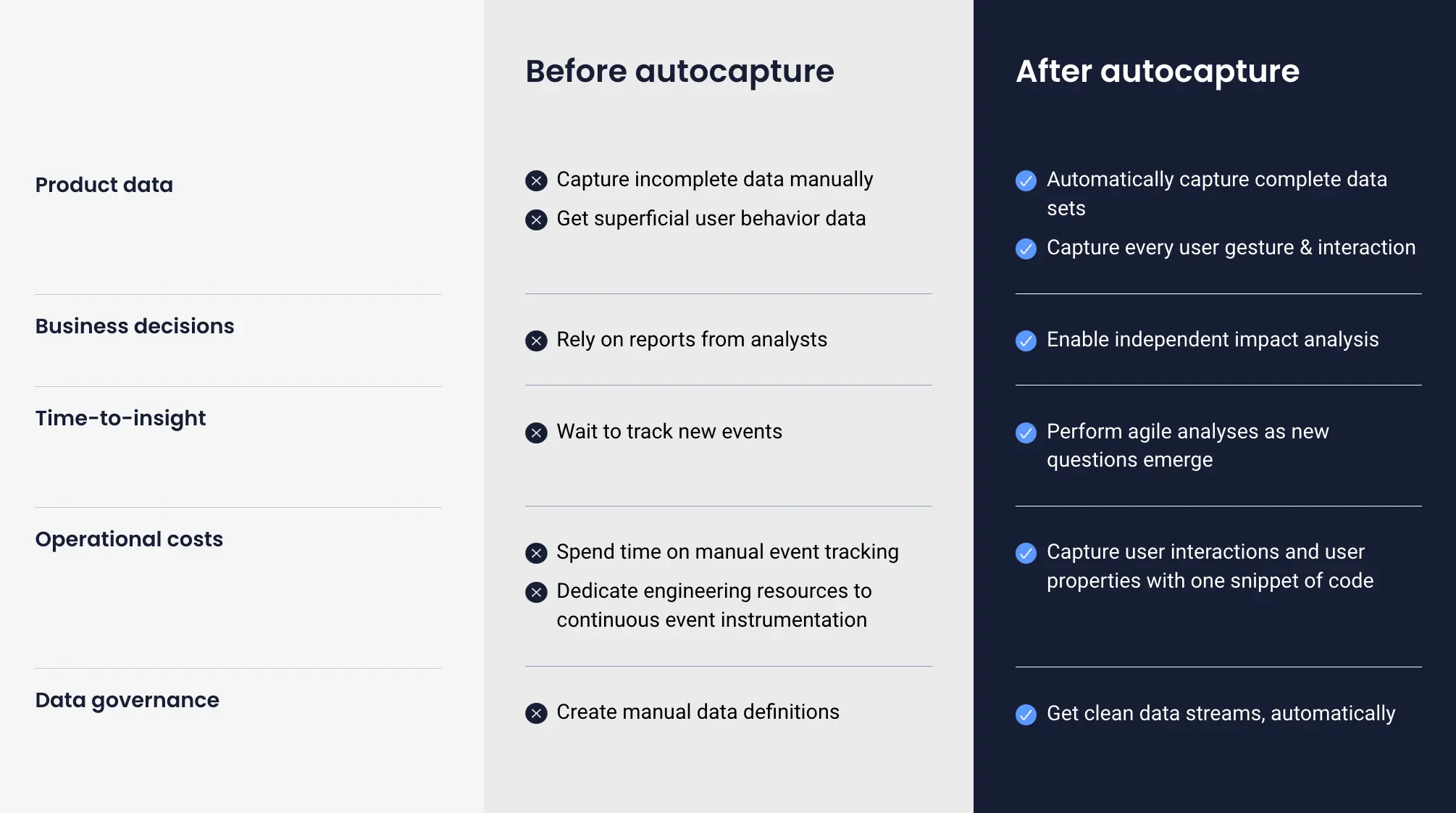Back to blog
16 MIN READ
Product Adoption Funnel - Stages and How to Optimize Them
PUBLISHED
14 January, 2025

Product Analytics Expert
A product adoption funnel helps product managers understand how users move from discovering a product to becoming loyal advocates.
By analyzing key stages—Awareness, Onboarding, Engagement, Retention, and Advocacy—managers can optimize user experiences and drive growth.
In this guide explores each stage and demonstrates how the best product managers leverage UXCam to easily and quickly surface actionable insights.
Summary - Product adoption analytics
| Question | Answer |
|---|---|
| What is a product adoption funnel? | A framework tracking user progress through stages: awareness, onboarding, activation, engagement, retention, and advocacy. |
| Why is tracking product adoption important? | It identifies issues, improves experiences, and helps grow your app by revealing insights on discovery, value, and retention. |
| Why is product adoption critical? | It ensures retention, engagement, and revenue by helping users see value and stay loyal. |
| What challenges exist in understanding adoption? | Finding user struggles, interpreting data, and handling nonlinear behaviors; tools like session replays help resolve this. |
| What are the stages of the adoption funnel? | Awareness, onboarding, activation, engagement, retention, and advocacy. |
| How do you optimize onboarding? | Simplify steps, give clear guidance, and fix issues using session replays. |
| How do you boost activation rates? | Highlight value, use incentives, and improve CTAs and prompts. |
| What’s essential for retaining users? | Personalize, analyze trends, and re-engage users with tailored strategies. |
| How do you encourage advocacy? | Offer referral rewards, ask for reviews, and track NPS and referrals. |
| How do you measure and improve the funnel? | Set benchmarks, test changes, and optimize using session replays, heatmaps, and cohorts. |
| What tools help optimize the funnel? | UXCam provides replays, funnels, heatmaps, and cohorts for insights. |
What is a product adoption funnel?
A product adoption funnel is a step-by-step framework that tracks how users progress from discovering your product to becoming loyal advocates. Think of it as a map for user behavior.
Each stage represents a critical milestone: awareness, onboarding, activation, engagement, retention, and advocacy. By understanding these stages, you can pinpoint where users drop off and take action to guide them toward success.
A product adoption funnel highlights how effectively users interact with your app. It ensures your efforts align with their needs and expectations.
Why tracking product adoption matters
Tracking product adoption helps you answer the most important questions about your app:
Are users discovering your app easily?
Do they understand its value?
Are they sticking around or leaving after a single session?
When you track adoption, you gain clarity about your user journey. This clarity helps you design better experiences, fix bottlenecks, and ultimately, grow your app’s user base.
Adoption insights can reveal hidden patterns. For example, you may discover that a confusing onboarding flow is preventing users from activating key features.
Why is product adoption important?
Product adoption directly impacts your app’s retention, engagement, and revenue. Without adoption, there’s no growth. A smooth adoption process ensures users stick around long enough to see your product’s true value.
Retention is often the first sign of strong adoption. If users leave quickly, it’s a sign they didn’t connect with your app. Improving adoption leads to better retention and higher lifetime value.
Engagement also thrives on adoption. Users who understand your product are more likely to explore its features, recommend it to others, and stay loyal over time.
Revenue is another key benefit. Users who adopt your product well are more likely to pay for premium features or subscribe to long-term plans. Adoption fuels the business side of your app.
Common challenges in understanding adoption
One of the biggest challenges is identifying where users struggle. Without the right tools, it’s hard to know why users aren’t progressing through your funnel.
For example, you might see a drop-off in sign-ups but not know if the issue is a confusing form, slow loading times, or unclear messaging. Each of these issues requires a different solution.
Another challenge is interpreting raw data. Metrics alone don’t tell the full story. You need tools that show not just what is happening but also why. This is where session replays or funnel analytics can help.
Finally, adoption isn’t linear. Users may skip steps, return to earlier stages, or behave differently than expected. Your funnel needs to account for these variations.
<div style="position: relative; padding-bottom: calc(54.285714285714285% + 41px); height: 0; width: 100%;"><iframe src="https://demo.arcade.software/cliohgyPDHNipCEA9RrI?embed&embed_mobile=inline&embed_desktop=inline&show_copy_link=true" title="Improve Onboarding Funnels" frameborder="0" loading="lazy" webkitallowfullscreen mozallowfullscreen allowfullscreen allow="clipboard-write" style="position: absolute; top: 0; left: 0; width: 100%; height: 100%; color-scheme: light;" ></iframe></div>
Stages of a product adoption funnel
The product adoption funnel is more than just a theoretical model. It’s a roadmap to understanding how users interact with your app and where they might face obstacles. Let’s explore its key stages.
1. Awareness: How users discover your app
Awareness is the first stage of the funnel. It’s where potential users learn about your app for the very first time. This could be through ads, organic search, or word of mouth.
At this stage, you want to measure how effectively your marketing efforts generate interest. Key metrics include:
Installs: How many people are downloading your app?
Screen or Page Visits: How much traffic is your app store listing or landing page receiving?
Referrals: Are users recommending your app to others?
When these metrics are low, it signals that your marketing message might not be resonating or reaching the right audience. Awareness sets the foundation for everything that follows.
2. Onboarding: Setting the Right Expectations
Onboarding is where first impressions are made. It’s the stage where users interact with your app for the first time and decide whether it’s worth their time and effort.
This stage is crucial because it sets the tone for how users perceive your app. Effective onboarding helps users understand your app’s core value quickly and effortlessly.
Key onboarding metrics to track include:
Sign-ups: How many users are creating accounts?
Account Creation: Are they completing all required steps?
First Session Duration: Are users spending enough time to explore your app?
When onboarding falls short, users may abandon your app before they even experience its value. A confusing interface or lack of guidance can be major deal-breakers.
Use case: Identifying onboarding friction points With UXCam
Imagine you notice users dropping off during the onboarding process but aren’t sure why. This is where UXCam’s session replay can make a difference.
With session replay, you can watch real user sessions to uncover pain points. For instance, you might see users struggling with a complicated sign-up form or missing key navigation elements.


By identifying these friction points, you can make targeted improvements. Streamline the form, add clear instructions, or remove unnecessary steps to create a smoother onboarding flow.
The result? More users progress to the next stage of your funnel, boosting activation and engagement.
3. Activation: Helping users experience the core value
Activation is when your users experience the “aha” moment—the point where they realize the true value of your app. This is where curiosity turns into commitment.
To get there, users must complete a specific key action that reflects your app’s primary purpose. This could be tasks like completing a tutorial, uploading their first file, or making a first purchase.
Tracking these key actions is essential. Metrics like the number of first completions or the time it takes users to activate can help you identify patterns. Are most users dropping off before they hit this milestone? If yes, why?
This is where UXCam’s funnels become invaluable. Funnels allow you to map the user journey leading to activation. For example, you can see if users start a tutorial but abandon it midway. With this insight, you can tweak your app’s flow to guide users more effectively.

4. Engagement: Keeping users coming back for more
Once users experience the core value of your app, the next step is keeping them engaged. Engagement is about creating a habit—getting users to interact with your app regularly.
Metrics like the Daily Active Users (DAU) to Monthly Active Users (MAU) ratio provide a clear picture of user stickiness. A high DAU/MAU ratio means users are consistently coming back, which is a great indicator of strong engagement.
Another important metric is feature adoption rates. These show which features users are engaging with the most and which ones might need more visibility or improvement.
To understand these interactions better, use heatmaps. Heatmaps provide a visual representation of where users are spending the most time in your app. For example, if users frequently interact with one feature but ignore another, you’ll know where to focus your optimization efforts.


5. Retention: Building long-term relationships with users
Retention is the backbone of a successful app. It’s not enough to attract users—you need to keep them coming back. This stage ensures your app becomes a part of their routine.
Retention reflects long-term adoption. It’s about frequent usage over time, showing that users find your app valuable and essential. Without strong retention, your app risks losing relevance and momentum.
Start by tracking retention rates—how many users return after a day, a week, or a month. High retention rates mean users find consistent value in your app.
Another key metric is repeat actions. Are users consistently completing actions like making purchases, logging in, or engaging with key features? These behaviors indicate long-term satisfaction.
To go deeper, use UXCam’s cohort analysis. This tool helps you group users based on when they joined and see how their retention trends over time. For example, you can compare how new feature rollouts impact retention for different user groups.
With these insights, you can tailor strategies to keep users engaged, whether it’s through personalized reminders, feature updates, or targeted in-app messages.

6. Advocacy: Turning loyal users into advocates
Advocacy is the ultimate goal of any app journey. When users become advocates, they don’t just stick around—they actively promote your app to others. Advocacy drives organic growth like nothing else.
Metrics like Net Promoter Score (NPS) help you measure advocacy. Ask users how likely they are to recommend your app to friends or colleagues. High NPS scores show that users trust and love your product.
Other advocacy metrics include social shares and referrals. These show how often users are spreading the word about your app, whether through social media or direct recommendations.
Encouraging advocacy starts with delighting your users. Offer incentives like referral bonuses, create shareable content, or simply ask for reviews. The key is to make it easy for users to champion your app.
By focusing on retention and advocacy, you’re not just building a user base—you’re creating a community. With tools like cohort analysis and actionable metrics, UXCam helps you understand and nurture these relationships for long-term success.
How to build a product adoption funnel
Creating a product adoption funnel is about understanding your users’ journey and ensuring every step leads them closer to success. A well-designed funnel gives you clarity and actionable insights.
Here’s how you can build one for your app, step by step.
Step 1 - Map out the Customer Journey
The first step is mapping your customer journey. This means identifying every touchpoint where users interact with your app. These touchpoints provide the foundation for your adoption funnel.
Think of your app as a story. What’s the first chapter? Is it a sign-up page, a tutorial, or a product demo? Then, outline the next steps they’ll take as they explore your app.
Start by asking yourself:
How do users discover your app?
What actions do they take during onboarding?
Where do they interact most often?
Visualizing this journey helps you spot gaps or friction points. For example, do users drop off after creating an account? Or are they struggling to complete a tutorial?
Break the journey into stages—Awareness, Onboarding, Activation, Engagement, Retention, and Advocacy. Each stage should correspond to specific actions and measurable outcomes.
By defining these touchpoints clearly, you’ll know what to track and how to guide users through the funnel.
Step 2- Tag events and screens
Once you’ve mapped the journey, it’s time to tag the events and screens that matter. This step ensures you’re collecting the right data to measure and optimize the funnel.
Event tagging captures specific user actions, like signing up, completing a task, or making a purchase. Screen tagging, on the other hand, tracks the different app screens users navigate through.
Proper tagging is crucial. Without it, you might miss critical data or fail to connect actions to outcomes. A poorly tagged funnel is like flying blind—you’ll have the numbers but no meaningful context. Make sure you’re capturing both high-level actions (e.g., sign-ups) and granular interactions (e.g., button clicks).
Here’s where UXCam’s auto-capture feature can save the day. Auto-capture reduces the manual effort required for tagging by automatically collecting key user interactions. This ensures comprehensive data without missing important details.
For example, if a user completes a key action across multiple screens, auto-capture helps you see the entire journey without needing to predefine every possible event.

Step 3 - Define key metrics for each stage
Every stage of your product adoption funnel has specific goals. To measure success, you need to track the right metrics—ones that are actionable and directly tied to user behavior.
Start by breaking down your funnel into its core stages: Awareness, Onboarding, Activation, Engagement, Retention, and Advocacy. For each stage, identify a primary KPI that reflects user progress.
For example:
Awareness: Track app installs, website visits, or ad click-through rates.
Onboarding: Measure sign-up completions or first-session duration.
Activation: Focus on first key actions, like completing a tutorial or uploading a file.
Engagement: Use DAU/MAU ratios or feature adoption rates.
Retention: Monitor returning users over time.
Advocacy: Evaluate Net Promoter Scores (NPS) or referral program activity.
These metrics help you identify bottlenecks. If users aren’t completing onboarding, for example, you’ll know to revisit that stage.
To prioritize these KPIs, ask: Which metric directly aligns with your app’s goals? Start there, then layer in secondary metrics to gain deeper insights.
Step 4 - Create and validate funnels
Once you’ve defined your metrics, it’s time to create funnels that mirror your user journey. Funnels visualize how users move through your app, from first interaction to becoming loyal advocates.
Set up your funnel by selecting key events for each stage. For example, a funnel for onboarding might include:
App install
Account creation
Tutorial completion
As users move through these steps, funnel analytics show how many progress and where they drop off. This clarity is essential for optimization.
To validate your funnel, ensure the events align with real user behavior. If an event isn’t firing or doesn’t reflect user intent, it can skew your insights.
Use case: How UXCam’s funnel visualization highlights weak points
Here’s where UXCam’s funnel visualization becomes a game-changer. It doesn’t just track drop-offs; it shows you exactly where users are struggling and why.
For instance, imagine users install your app but don’t complete onboarding. UXCam’s funnel lets you see which specific step causes the drop-off—whether it’s a confusing form, a slow-loading screen, or unclear instructions.
By combining this insight with session replays, you can pinpoint the exact moments users lose interest. Maybe the onboarding flow is too long, or a critical CTA is hard to find.
With this data, you can make targeted changes. Simplify the flow, improve loading times, or redesign the CTA. The result? A smoother journey that keeps users moving forward.
How to optimize the product adoption funnel
Building a product adoption funnel is just the start. The real work lies in optimizing it. This means identifying weak points, making improvements, and ensuring users have a seamless journey from start to finish.
Here’s how you can fine-tune each stage to maximize adoption and engagement.
1. Reducing friction in onboarding
Onboarding is your first chance to make a great impression. A smooth onboarding experience helps users understand your app’s value quickly and keeps them moving forward.
Start by keeping the process simple. Avoid overwhelming users with too many steps or features. Focus on guiding them toward a single key action that demonstrates your app’s core value.
Use clear, actionable instructions and ensure CTAs are easy to find. If your onboarding includes forms, keep them short and remove unnecessary fields.
To spot issues, turn to UXCam’s session replay. This tool allows you to watch how first-time users navigate your app. Are they getting stuck on a particular step? Is something confusing or broken? With session replay, you can identify these pain points and fix them fast.


2. Improve activation rates
Activation is when users realize why your app matters. To improve activation rates, focus on encouraging key actions that demonstrate your app’s core value.
One strategy is to provide incentives or rewards for completing these actions. For example, offer a free trial or unlock a feature once users finish a tutorial.
Another approach is to guide users with contextual prompts. Use in-app messages or tooltips to highlight the benefits of specific features and encourage engagement.
If your CTAs aren’t performing, try using heatmaps. Heatmaps show where users are clicking—or not clicking—in your app. For example, if a critical CTA is ignored, you might need to redesign it or change its placement.
3. Boost retention
Retention is about building lasting relationships with your users. Personalization and segmentation are key to keeping users engaged over time.
Segment your audience based on behavior, demographics, or preferences. Then, tailor your messages and offers to each group. For instance, send reminders to users who haven’t returned in a week, or offer tips to those exploring a specific feature.
Leverage UXCam’s cohort analysis to identify trends in user retention. For example, you can see how users who joined during a promotion compare to those who didn’t. This insight helps you craft targeted retention campaigns.
By retargeting cohorts with personalized messages, you can re-engage users and keep them coming back for more.
4. Encourage advocacy
Advocacy is the ultimate goal. It’s when your users are so delighted they start promoting your app to others. To encourage advocacy, make it rewarding and effortless.
Start by incentivizing referrals. Offer discounts, free features, or other perks for users who bring in friends. Highlight these programs in-app so users know they exist.
Ask for reviews at the right time—like after a user completes a key action or milestone. A simple prompt can lead to positive feedback that boosts your app’s reputation.
Track metrics like referral clicks, shares, and reviews to measure advocacy success. These numbers show how well your strategies are working and where there’s room for improvement.
How to measure and iterate on the funnel
Your product adoption funnel is never static. It evolves as user behaviors change and your app grows. Measuring its performance and continuously iterating are key to keeping it effective and relevant.
Here’s how you can establish a feedback loop to optimize your funnel.
1. Setting baselines and benchmarks
Before you can improve your funnel, you need a starting point. Establish baselines and benchmarks to understand where you are and what success looks like.
Start by analyzing current metrics for each funnel stage. How many users move from onboarding to activation? What percentage of users return after their first session? These numbers serve as your baseline.
Next, set realistic benchmarks based on industry standards or historical performance. For example, a 20% drop-off during onboarding might be acceptable for some apps but too high for yours. Use these benchmarks to guide your goals.
Remember, your benchmarks should align with your app’s unique objectives. For instance, if your app is subscription-based, prioritize metrics like retention and activation over awareness.
2. A/B Test in the funnel
Once you have baselines, the next step is to experiment. A/B testing is a powerful way to identify what works and what doesn’t in your funnel.
Test one variable at a time to isolate its impact. For example, experiment with two onboarding flows—one that includes a tutorial and one that skips it. Compare metrics like completion rates and activation to see which performs better.
You can also test variations of CTAs, feature placements, or even messaging. For instance, if users aren’t clicking a “Start Now” button, try changing the text to “Get Started Today” or moving it to a more prominent position.
By running these tests, you gain data-driven insights to refine your funnel step by step.
3. Continuous improvement
Optimization doesn’t end with one round of testing. Your funnel should constantly evolve based on user feedback, new features, and shifting trends.
UXCam plays a crucial role here. Use session replays to understand user behavior beyond the numbers. For example, if you notice a drop-off in a specific funnel stage, session replays can reveal whether users are confused or frustrated.
Heatmaps and cohort analysis further help you uncover patterns. If a particular cohort shows higher retention, examine what worked for them and apply those learnings to other segments.
Regularly review your metrics, revalidate assumptions, and iterate. Small, incremental changes often lead to significant improvements over time.
Use case: Successful funnel optimization using UXCam
Let’s say your app is experiencing high drop-offs during onboarding. By using UXCam’s session replay, you notice that users abandon the process when uploading a profile picture.
With this insight, you A/B test an alternative flow that skips the profile picture step and makes it optional later. Post-launch metrics show a 30% improvement in onboarding completion.
Next, you analyze heatmaps and see that the new onboarding flow encourages more users to activate key features. Retention rates for these users also improve, as confirmed through cohort analysis.
This iterative approach demonstrates how measuring, testing, and optimizing can transform your funnel and drive meaningful results.
Conclusion
Building and optimizing a product adoption funnel doesn’t have to be overwhelming. By breaking it into clear stages—Awareness, Onboarding, Activation, Engagement, Retention, and Advocacy—you can understand your users’ journey and guide them toward success.
Throughout this guide, you’ve learned actionable strategies to reduce friction, improve activation, and boost retention. From tagging events and tracking key metrics to using A/B testing and heatmaps, you now have a roadmap to refine your funnel step by step.
UXCam makes this process seamless. With features like session replay, funnel visualization, cohort analysis, and heatmaps, UXCam provides end-to-end visibility into your users’ behavior. It’s the insight you need to identify bottlenecks, optimize experiences, and drive adoption.
The time to start is now. Don’t wait to uncover where your users are struggling and how you can make their journey better. Small improvements to your funnel today can lead to huge wins tomorrow.
Ready to take the next step? Try UXCam for free and see how it transforms your product adoption funnel. With the right tools, you can create a journey that keeps users coming back for more
You might also be interested in these;
How to analyze session recordings
Product Feature Analysis - A Step-by-Step Guide
Product Adoption Dashboard Examples & Key Metrics to Track
Stages of the product adoption process - An indepth guide
How to measure product adoption (metrics, formulas & tools)
5 Best product adoption software tools to build stickier apps
AUTHOR

Tope Longe
Product Analytics Expert
Ardent technophile exploring the world of mobile app product management at UXCam.
What’s UXCam?
Related articles
App Analytics
Mobile App Tracking: Practical Guide & Best Tools [2026]
The best tracking tools for mobile...

Jonas Kurzweg
Product Analytics Expert
App Analytics
Top Analytics SDKs 2026
Pick the right analytics SDKs to improve your app's...

Jonas Kurzweg
Product Analytics Expert
Product best practices
8 Best UX Analytics Tools and Software We’ve Tested 2025
A good UX design is key when it comes to user satisfaction. Learn about five of the best UX analytics tools you can use to get valuable insights about user...

Jonas Kurzweg
Product Analytics Expert


